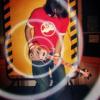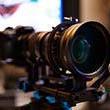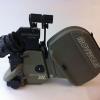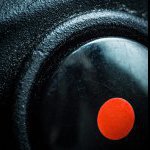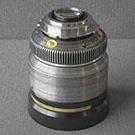
Axel
-
Posts
1,900 -
Joined
-
Last visited
Reputation Activity
-

-
 Axel reacted to pooli in REDpooliRIG for BMPCC
Axel reacted to pooli in REDpooliRIG for BMPCC
Hello Forum!
I'm from Russia
This is my design - rig for BMPCC
-
 Axel reacted to Rungunshoot in Inspiration & Neatvideo
Axel reacted to Rungunshoot in Inspiration & Neatvideo
Hey Skip,
Regarding NeatVideo, yes, get it. It's a lifesaver about half the time and unusable about half the time (if the footage is too mushy and grainy), but it will save your ass at some point.
Regarding test footage, try this: try to get a stranger to let you film their daily life for an hour or two. Somebody random off the street from a radically different walk of life. Show them a little reel of your work on your phone if possible in order to get them to agree. Then try to film them in an up-close, intimate way that sheds new light on the details of how they live. Try to use only natural sound, no music, for a challenge.
Example:
OR try to re-work your b-roll footage into something with spoken narration to give it a tone poem feel. Maybe use your own voice for VO.
Example:
-
 Axel got a reaction from Ernesto Mantaras in Blackmagic Pocket Cinema Camera Review - Final Part
Axel got a reaction from Ernesto Mantaras in Blackmagic Pocket Cinema Camera Review - Final Part
I had been a projectionist for a long time (now this profession has died), and from 2000 on I had also been a digital projectionist. Until 2011, when automation finally killed the job, I used to compare my own stuff to the DCPs, side by side on the big screens, in the last two years also as DCPs, when easyDCP and openDCP became available. The largest screen was 78 feet x 32 feet (that's for scope, for 16:9 the width then was 58 feet).
First thing I noticed is that resolution doesn't influence sharpness to the expected degree. And it also doesn't influence subjective quality very much. In fact, an upscaled SD DVD ( anamorph pixels with scope-crop, really the worst way to treat a video) could be shown to a big audience, and (back then) nobody complained, the class-A hardware scalers made it look good. I know this is hard to believe, but we once had a festival with student films, ranging from DVD, BD to genuine DCP (a Red!), and the one best looking was a masterfully graded HVX200 short, played from SD DVD.
On the other hand, there was a way to know instantaneously what was film and what was video: Colors.
I know this comparison is only 8-bit, but I have to find a way to describe aesthetic subtleties here. With a camera like the GH2 ("Musgo"), for example, one would be well advised to fill the frame with detail, textures (resolution, that's the GH2s strength) and not with skies and other big areas of glorious colors.
Right now we grade for 8-bit, so 12-bit raw is *just* a bigger palette for grading. Color depth seems to add a new dimension to our video. It's fun to tear the, er, bloom off the images and to dive through the colors. Would it stand against an Alexa? I can't tell, really, but I'm convinced it would do better than many others.
I can't wait to see a DCP with the 12-bit preserved in my old cinema.
-
 Axel got a reaction from nahua in Blackmagic Pocket Cinema Camera Review - Final Part
Axel got a reaction from nahua in Blackmagic Pocket Cinema Camera Review - Final Part
I had been a projectionist for a long time (now this profession has died), and from 2000 on I had also been a digital projectionist. Until 2011, when automation finally killed the job, I used to compare my own stuff to the DCPs, side by side on the big screens, in the last two years also as DCPs, when easyDCP and openDCP became available. The largest screen was 78 feet x 32 feet (that's for scope, for 16:9 the width then was 58 feet).
First thing I noticed is that resolution doesn't influence sharpness to the expected degree. And it also doesn't influence subjective quality very much. In fact, an upscaled SD DVD ( anamorph pixels with scope-crop, really the worst way to treat a video) could be shown to a big audience, and (back then) nobody complained, the class-A hardware scalers made it look good. I know this is hard to believe, but we once had a festival with student films, ranging from DVD, BD to genuine DCP (a Red!), and the one best looking was a masterfully graded HVX200 short, played from SD DVD.
On the other hand, there was a way to know instantaneously what was film and what was video: Colors.
I know this comparison is only 8-bit, but I have to find a way to describe aesthetic subtleties here. With a camera like the GH2 ("Musgo"), for example, one would be well advised to fill the frame with detail, textures (resolution, that's the GH2s strength) and not with skies and other big areas of glorious colors.
Right now we grade for 8-bit, so 12-bit raw is *just* a bigger palette for grading. Color depth seems to add a new dimension to our video. It's fun to tear the, er, bloom off the images and to dive through the colors. Would it stand against an Alexa? I can't tell, really, but I'm convinced it would do better than many others.
I can't wait to see a DCP with the 12-bit preserved in my old cinema.
-
 Axel got a reaction from odie in Blackmagic Pocket Cinema Camera Review - Final Part
Axel got a reaction from odie in Blackmagic Pocket Cinema Camera Review - Final Part
I had been a projectionist for a long time (now this profession has died), and from 2000 on I had also been a digital projectionist. Until 2011, when automation finally killed the job, I used to compare my own stuff to the DCPs, side by side on the big screens, in the last two years also as DCPs, when easyDCP and openDCP became available. The largest screen was 78 feet x 32 feet (that's for scope, for 16:9 the width then was 58 feet).
First thing I noticed is that resolution doesn't influence sharpness to the expected degree. And it also doesn't influence subjective quality very much. In fact, an upscaled SD DVD ( anamorph pixels with scope-crop, really the worst way to treat a video) could be shown to a big audience, and (back then) nobody complained, the class-A hardware scalers made it look good. I know this is hard to believe, but we once had a festival with student films, ranging from DVD, BD to genuine DCP (a Red!), and the one best looking was a masterfully graded HVX200 short, played from SD DVD.
On the other hand, there was a way to know instantaneously what was film and what was video: Colors.
I know this comparison is only 8-bit, but I have to find a way to describe aesthetic subtleties here. With a camera like the GH2 ("Musgo"), for example, one would be well advised to fill the frame with detail, textures (resolution, that's the GH2s strength) and not with skies and other big areas of glorious colors.
Right now we grade for 8-bit, so 12-bit raw is *just* a bigger palette for grading. Color depth seems to add a new dimension to our video. It's fun to tear the, er, bloom off the images and to dive through the colors. Would it stand against an Alexa? I can't tell, really, but I'm convinced it would do better than many others.
I can't wait to see a DCP with the 12-bit preserved in my old cinema.
-
 Axel got a reaction from QuickHitRecord in Blackmagic Pocket Cinema Camera Review - Final Part
Axel got a reaction from QuickHitRecord in Blackmagic Pocket Cinema Camera Review - Final Part
I had been a projectionist for a long time (now this profession has died), and from 2000 on I had also been a digital projectionist. Until 2011, when automation finally killed the job, I used to compare my own stuff to the DCPs, side by side on the big screens, in the last two years also as DCPs, when easyDCP and openDCP became available. The largest screen was 78 feet x 32 feet (that's for scope, for 16:9 the width then was 58 feet).
First thing I noticed is that resolution doesn't influence sharpness to the expected degree. And it also doesn't influence subjective quality very much. In fact, an upscaled SD DVD ( anamorph pixels with scope-crop, really the worst way to treat a video) could be shown to a big audience, and (back then) nobody complained, the class-A hardware scalers made it look good. I know this is hard to believe, but we once had a festival with student films, ranging from DVD, BD to genuine DCP (a Red!), and the one best looking was a masterfully graded HVX200 short, played from SD DVD.
On the other hand, there was a way to know instantaneously what was film and what was video: Colors.
I know this comparison is only 8-bit, but I have to find a way to describe aesthetic subtleties here. With a camera like the GH2 ("Musgo"), for example, one would be well advised to fill the frame with detail, textures (resolution, that's the GH2s strength) and not with skies and other big areas of glorious colors.
Right now we grade for 8-bit, so 12-bit raw is *just* a bigger palette for grading. Color depth seems to add a new dimension to our video. It's fun to tear the, er, bloom off the images and to dive through the colors. Would it stand against an Alexa? I can't tell, really, but I'm convinced it would do better than many others.
I can't wait to see a DCP with the 12-bit preserved in my old cinema.
-
 Axel got a reaction from maxotics in Blackmagic Pocket Cinema Camera Review - Final Part
Axel got a reaction from maxotics in Blackmagic Pocket Cinema Camera Review - Final Part
I had been a projectionist for a long time (now this profession has died), and from 2000 on I had also been a digital projectionist. Until 2011, when automation finally killed the job, I used to compare my own stuff to the DCPs, side by side on the big screens, in the last two years also as DCPs, when easyDCP and openDCP became available. The largest screen was 78 feet x 32 feet (that's for scope, for 16:9 the width then was 58 feet).
First thing I noticed is that resolution doesn't influence sharpness to the expected degree. And it also doesn't influence subjective quality very much. In fact, an upscaled SD DVD ( anamorph pixels with scope-crop, really the worst way to treat a video) could be shown to a big audience, and (back then) nobody complained, the class-A hardware scalers made it look good. I know this is hard to believe, but we once had a festival with student films, ranging from DVD, BD to genuine DCP (a Red!), and the one best looking was a masterfully graded HVX200 short, played from SD DVD.
On the other hand, there was a way to know instantaneously what was film and what was video: Colors.
I know this comparison is only 8-bit, but I have to find a way to describe aesthetic subtleties here. With a camera like the GH2 ("Musgo"), for example, one would be well advised to fill the frame with detail, textures (resolution, that's the GH2s strength) and not with skies and other big areas of glorious colors.
Right now we grade for 8-bit, so 12-bit raw is *just* a bigger palette for grading. Color depth seems to add a new dimension to our video. It's fun to tear the, er, bloom off the images and to dive through the colors. Would it stand against an Alexa? I can't tell, really, but I'm convinced it would do better than many others.
I can't wait to see a DCP with the 12-bit preserved in my old cinema.
-
 Axel got a reaction from andy lee in Blackmagic Pocket Cinema Camera Review - Final Part
Axel got a reaction from andy lee in Blackmagic Pocket Cinema Camera Review - Final Part
I had been a projectionist for a long time (now this profession has died), and from 2000 on I had also been a digital projectionist. Until 2011, when automation finally killed the job, I used to compare my own stuff to the DCPs, side by side on the big screens, in the last two years also as DCPs, when easyDCP and openDCP became available. The largest screen was 78 feet x 32 feet (that's for scope, for 16:9 the width then was 58 feet).
First thing I noticed is that resolution doesn't influence sharpness to the expected degree. And it also doesn't influence subjective quality very much. In fact, an upscaled SD DVD ( anamorph pixels with scope-crop, really the worst way to treat a video) could be shown to a big audience, and (back then) nobody complained, the class-A hardware scalers made it look good. I know this is hard to believe, but we once had a festival with student films, ranging from DVD, BD to genuine DCP (a Red!), and the one best looking was a masterfully graded HVX200 short, played from SD DVD.
On the other hand, there was a way to know instantaneously what was film and what was video: Colors.
I know this comparison is only 8-bit, but I have to find a way to describe aesthetic subtleties here. With a camera like the GH2 ("Musgo"), for example, one would be well advised to fill the frame with detail, textures (resolution, that's the GH2s strength) and not with skies and other big areas of glorious colors.
Right now we grade for 8-bit, so 12-bit raw is *just* a bigger palette for grading. Color depth seems to add a new dimension to our video. It's fun to tear the, er, bloom off the images and to dive through the colors. Would it stand against an Alexa? I can't tell, really, but I'm convinced it would do better than many others.
I can't wait to see a DCP with the 12-bit preserved in my old cinema.
-
 Axel got a reaction from Francisco Rios in Blackmagic Pocket Cinema Camera Review - Final Part
Axel got a reaction from Francisco Rios in Blackmagic Pocket Cinema Camera Review - Final Part
I had been a projectionist for a long time (now this profession has died), and from 2000 on I had also been a digital projectionist. Until 2011, when automation finally killed the job, I used to compare my own stuff to the DCPs, side by side on the big screens, in the last two years also as DCPs, when easyDCP and openDCP became available. The largest screen was 78 feet x 32 feet (that's for scope, for 16:9 the width then was 58 feet).
First thing I noticed is that resolution doesn't influence sharpness to the expected degree. And it also doesn't influence subjective quality very much. In fact, an upscaled SD DVD ( anamorph pixels with scope-crop, really the worst way to treat a video) could be shown to a big audience, and (back then) nobody complained, the class-A hardware scalers made it look good. I know this is hard to believe, but we once had a festival with student films, ranging from DVD, BD to genuine DCP (a Red!), and the one best looking was a masterfully graded HVX200 short, played from SD DVD.
On the other hand, there was a way to know instantaneously what was film and what was video: Colors.
I know this comparison is only 8-bit, but I have to find a way to describe aesthetic subtleties here. With a camera like the GH2 ("Musgo"), for example, one would be well advised to fill the frame with detail, textures (resolution, that's the GH2s strength) and not with skies and other big areas of glorious colors.
Right now we grade for 8-bit, so 12-bit raw is *just* a bigger palette for grading. Color depth seems to add a new dimension to our video. It's fun to tear the, er, bloom off the images and to dive through the colors. Would it stand against an Alexa? I can't tell, really, but I'm convinced it would do better than many others.
I can't wait to see a DCP with the 12-bit preserved in my old cinema.
-
 Axel got a reaction from KarimNassar in Blackmagic Pocket Cinema Camera Review - Final Part
Axel got a reaction from KarimNassar in Blackmagic Pocket Cinema Camera Review - Final Part
I had been a projectionist for a long time (now this profession has died), and from 2000 on I had also been a digital projectionist. Until 2011, when automation finally killed the job, I used to compare my own stuff to the DCPs, side by side on the big screens, in the last two years also as DCPs, when easyDCP and openDCP became available. The largest screen was 78 feet x 32 feet (that's for scope, for 16:9 the width then was 58 feet).
First thing I noticed is that resolution doesn't influence sharpness to the expected degree. And it also doesn't influence subjective quality very much. In fact, an upscaled SD DVD ( anamorph pixels with scope-crop, really the worst way to treat a video) could be shown to a big audience, and (back then) nobody complained, the class-A hardware scalers made it look good. I know this is hard to believe, but we once had a festival with student films, ranging from DVD, BD to genuine DCP (a Red!), and the one best looking was a masterfully graded HVX200 short, played from SD DVD.
On the other hand, there was a way to know instantaneously what was film and what was video: Colors.
I know this comparison is only 8-bit, but I have to find a way to describe aesthetic subtleties here. With a camera like the GH2 ("Musgo"), for example, one would be well advised to fill the frame with detail, textures (resolution, that's the GH2s strength) and not with skies and other big areas of glorious colors.
Right now we grade for 8-bit, so 12-bit raw is *just* a bigger palette for grading. Color depth seems to add a new dimension to our video. It's fun to tear the, er, bloom off the images and to dive through the colors. Would it stand against an Alexa? I can't tell, really, but I'm convinced it would do better than many others.
I can't wait to see a DCP with the 12-bit preserved in my old cinema.
-
 Axel reacted to maxotics in Blackmagic Pocket Cinema Camera Review - Final Part
Axel reacted to maxotics in Blackmagic Pocket Cinema Camera Review - Final Part
Very nice review as always. I would add this:
o. Takes 24 to 30 1920x1080 RAW (DNG) photographs per second. These images can be post-processed by almost every photo processing software known to man :)
o. Showing 24 fully-realized photos per second is what real film does.
o. If you were on a million dollar movie set and shot side-by-side with the production camera and showed it in a theater most people would not see much of a difference. Am I wrong?
o. If the BMPCC shot 720p it would be a fantastic achievement! I'll argue the camera is already 2nd gen.
o. The BMPCC simply blows away camcorders from a few years ago.
o. Davinci Resolve Lite adds thousands to the value of the camera.
o. H.264 looks like complete crap in low-light. The BMPCC has a natural grain/noise look. Sensor size doesn't even come into play.
o. The 5D3 is it's closest competitor and the CF cards are very expensive and ML untrustworthy.
The only negative about the camera for me is I no longer have ANY EXCUSE whatsoever to film anything creative. Yes, it's easy to want this and that lens, and rig, and whatever. Yet what you can do with the BMPCC and a cheap 14-45 IOS lens is, quite simply, STAGGERING. Seriously, every day I don't use it I feel a bit ashamed.
-
 Axel got a reaction from KarimNassar in BMPCC raw inferior to 5DMiii
Axel got a reaction from KarimNassar in BMPCC raw inferior to 5DMiii
Hi folks,
everyone have a nice christmas!
I have the Pocket, the Pocket Speedbooster and the Sigma 18-35mm now for a couple of days and - of course - made some test shots. A lot of them, to be precise.
I will upload anything worth showing as soon as I'll have figured out how to do it right. All my preoccupations have vanished. This camera is great fun for me.
My computer can't yet handle raw with Resolve, so I'm using ACR within AAE (slooow), until I have decided whether I will upgrade my current machine or buy a new. However, I was not yet able to produce any moire, I found ETTR to be the correct way of exposing (I was able to produce noise, when not overexposing), I think there is a way to deal with everything.
The display isn't as bad as was hawked, it just needs a Z-finder (similar products by Kinotehnik and Kamerar). No need for a rig with the Sigma. I just drew a nylon strap (leftover from one of my various camera bags) through the slit of my ACE plate.
I basically hold the lens, not the camera. Together with the Z-finder, I will have 3-point stabilization.
To all purchasers who wait in doubt and despair: Don't worry.
EDIT: Definite workaround for the "ETTR-issue". In raw, set ISO to 400, this will lower the gamma at which the image is displayed in display and later on the computer (manner of speaking, actually the gamma point is set to a higher value, the lever exposure in ACR is a gamma-corrected curve). Expose as bright as possible without 100% zebra flashing. The ISO settings have only influence on the metadata in raw. Proof: If you switch through 200-400-800-1600, the subjective brightness changes, but the zebra areas stay the same. It actually is easier to expose with the Pocket.
-
 Axel got a reaction from Sean Cunningham in BMCCP raw color correction
Axel got a reaction from Sean Cunningham in BMCCP raw color correction
And isn't that just great?
Watch The 36th Chamber Of Shaolin before you start grading ...
-
 Axel reacted to Sean Cunningham in BMCCP raw color correction
Axel reacted to Sean Cunningham in BMCCP raw color correction
Those examples are mostly due to limitations on the part of the person grading. Using canned or popular LUTs found on the internet is going to proliferate the same look and/or mistakes. Color is a more difficult subject to master than operation of the camera itself. Professionals have been struggling with it since the arrival of the earliest raw cinema cameras.
Look at early Red and Alexa and you see looks and mistakes repeated again and again, creating the false assumption in a lot of people there was a "look" for them. That lie lives on but now we have, as colorists have become more sophisticated and specific in their handling of these cameras along with improvements in color pipelines, films that share no similarities with the early footage and radically different aesthetics from the same camera.
-
 Axel got a reaction from Francisco Rios in Vote for BMPCC Software Features
Axel got a reaction from Francisco Rios in Vote for BMPCC Software Features
"Survey is invalid or no longer exists."
I think they know what people miss on the Pocket at Blackmagic.
Let me show my own list and please comment on it (in order of my personal priorities):
1. The remaining recording time must be shown on the OSD.
2. I'd like a little more contrast and saturation on the display (display menu settings: "Video").
3. If I play back a clip and press OK during it, I'd like to be asked "Delete clip?"
4. I'd like a ProRes (without HQ) option. You don't shoot the beauty shots with PR anyway, and for i.e. interviews the lower bitrate survives the grading you apply to it.
5. I'd like the camera to remember the iris values and peaking after putting it off or battery change.
Some things probably can't be changed, like audio quality. There is a project underway to make a specialized miniature stereo microphone with built-in pre-amp, based on a successful in-ear concept called Ohrwurm ("earworm") with distinct cardioid characteristics (self-contradictory though it sounds). It could be screwed to a cage and preserve the so-called stealth factor. This isn't going to be cheap. Otherwise there are external solutions, and with modern NLEs the need to synchronize in post has lost it's horrors.
Card formatting in camera? Why? You need a computer anyway to store the clips.
-
 Axel reacted to Guest in Advice on new Mac editing setup please!
Axel reacted to Guest in Advice on new Mac editing setup please!
I'm going around in circles guys - all options seem to have their benefits.
Like I say, I edit H264/AVCHD (from D5300 and G6) converted to prores in FCPX. I grade in FCPX. I use Neat Video a lot, but my Mac can barely cope with it (inadequate graphics card I think).
I would like a system that can deal with the above very easily (e.g. quickly render, analyse clips and add effects).
Ideally I would like the Mac to be somewhat futureproof (for example, ability to upgrade it and/or run resolve smoothly would be nice).
I'm mainly torn between a 27" iMac with top spec customisation, and a base spec Mac Pro. They work out at about the same price.
Perhaps a Mac Pro is a little overkill for what I'm currently doing, but seeing as I'm spending that amount of money anyway, wouldn't it be the better investment? How upgradeable are the new Mac Pro's?
It would also mean that I can buy a single monitor (just one for the time being) that can be properly calibrated.
Why buy an iMac when I can get a Mac Pro for the same price, and vice versa?
Advice appreciated ...
-
 Axel reacted to Guest in Speedbooster + Sigma + ND fader - do I need a bigger filter?
Axel reacted to Guest in Speedbooster + Sigma + ND fader - do I need a bigger filter?
Also remember that the glass on fader ND's is usually about one filter size larger than the thread size (to avoid vignetting). And if you're concerned about size at all, the 82mm Genus is going to be massive!
Is it the Genus Eclipse you are going for? AFAIK they are the best ...
-
 Axel reacted to austinmcconnell in Feature Film Shot on GH2
Axel reacted to austinmcconnell in Feature Film Shot on GH2
I shot this feature on a GH2 this summer. It will be out at the end of January. Here's one of the trailers.
-
 Axel reacted to paulraymaekers in remaining card space indicated in play back mode
Axel reacted to paulraymaekers in remaining card space indicated in play back mode
hi,
my bmpcc just arrived this morning
loaded the latest soft 1.5.1
I notice I can check the remaining time on the card: if you go to playback mode, the time indicated moves forth and back when you move trough the clips:
so the time indication at the start of each clip is the total time of all previously recorded clips
so when scrolling to the last clip, the total recorded time on the card is indicated time plus the length of the last clip
seems to work for me
-
 Axel got a reaction from richg101 in Pocket HDMI + connectors protector - who wants one?
Axel got a reaction from richg101 in Pocket HDMI + connectors protector - who wants one?
You are right. I just bought the only micro HDMI to mini HDMI cable I found on the net (to connect the Pocket to the Alphatron EVF), only to learn, that it's an ordinary HDMI-cable with two flimsy adapters.
But it would need to fit in the Continuo cage:
-
 Axel reacted to Bioskop.Inc in F0.74 - new Metabones Speed Boosters break boundaries
Axel reacted to Bioskop.Inc in F0.74 - new Metabones Speed Boosters break boundaries
http://www.kenrockwell.com/nikon/24f28.htm
Just a normal old manual Nikon 24mm f2.8 AI-S lens - v.close focusing & no distortion.
So no real catch, apart from you need 95mm or 82mm diopters (Tokina 72mm vignettes) for the Iscorama.
I think with the new Speedbooster i'm going to go Nikon, so only really need to get a 28mm & a 50mm.
-
 Axel reacted to Andrew Reid in F0.74 - new Metabones Speed Boosters break boundaries
Axel reacted to Andrew Reid in F0.74 - new Metabones Speed Boosters break boundaries
Today Metabones release two new Speed Boosters for Blackmagic shooters.
I've been using some demo samples for this special review and I'm absolutely stunned.
Metabones and Caldwell Optics have given us a Zeiss / Kubrick / NASA special! These adapters are completely new and purpose designed to fit only the Blackmagic cameras. Offering super bright apertures as fast as F0.74 and finally some great wide angle possibilities, I put both new adapters through their paces...
Read the full article here -
 Axel reacted to Rungunshoot in 5Dmkiii Raw In Dubai - Eoshd Lut
Axel reacted to Rungunshoot in 5Dmkiii Raw In Dubai - Eoshd Lut
My first few shots from my Dubai trip. Used the EOSHD 5D raw LUT in Resolve and it worked like a charm. I love how it lifts shadows without sacrificing black levels.
I exported the clips from resolve with the LUT and then did additional grading on top of that in FCP X.
-
 Axel got a reaction from nahua in Color correction for hybrid H.264/RAW
Axel got a reaction from nahua in Color correction for hybrid H.264/RAW
You better start with learning one, your CC software with the manual or better yet with a complete video tut training. Then there are some very general advices on requirements and workflow:
1. Calibrate your monitor(s) ...
2. Backlight them with 6500k balanced lights.
3. Paint the wall behind with a dark, neutral grey.
4. Exclude all strongly colored objects from your FOV.
5. Don't allow reflections or light temperatur mixes.
Workflow:
1. Optimize your clips (neutralize them). Don't trust your eyes. Use the scopes. This is primary CC.
2. Apply changes to selected areas of your images. This is secondary CC.
3. Find a look for the most enigmatic of your shots in one sequence. Now your taste and your good eye are asked for. Don't start this step when you're tired or not relaxed. This (on top of steps 1&2) is a grade. Copy the grade.
4. Apply the grade to the rest of the sequence, fine-tune it.
You will find, that by now clips from different cameras or with different lenses or exposure will look 98% as much congruent as possible.
5. Finally, iron out the missing 2% by comparing all your shots with the tools provided by your software (split screen, lighttable, whatever). After you graded for look, now grade for consistency.


